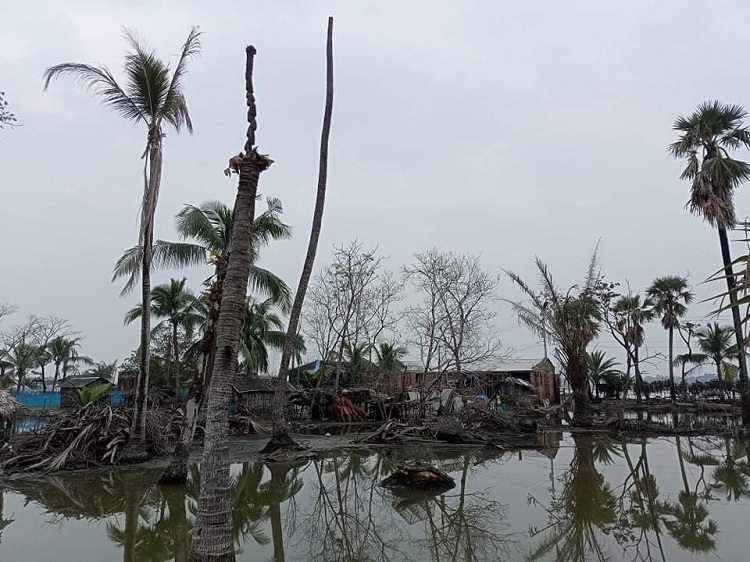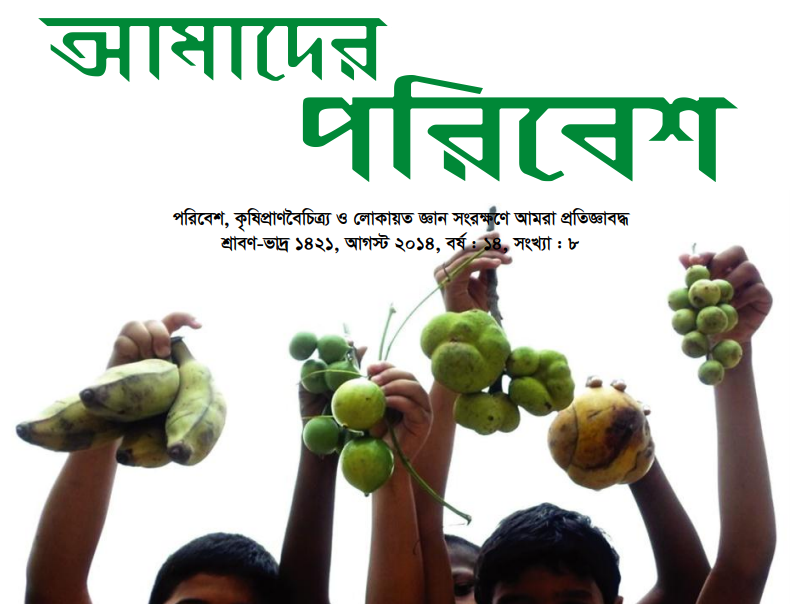Satkhira to Mrityunjoy Roy Apurba
The soil of Shyamnagar coastal region of Satkhira is burning due to salinity which is getting increasing day by day due to the impact of climate change. The climate induced disasters including the cyclones, sea level rise and salinity damage crop lands and pollute the sweet water sources intensifying the loss of agro-biodiversity in the coastal region. Due to these climate induced disasters people life and livelihood is at stake and their normal life get disrupted.
According to the statements of local people, every time due to natural disasters, new areas are flooded with salty water. The saline water contaminates fresh water sources such as river, ponds and other wetlands as well as decreases the fertility of the soils which create negative impacts on food production. People are now fighting with the salinity to uphold their existence. Due to the increase intrusion of salinity the coast is day by day turning into a desert as the vegetation dies.
However, according to a research report titled ‘River Salinity and Climate Change Evidence from Coastal Bangladesh’ by World Bank, 10 rivers’ water will be affected by excessive salinity in 148 upazillas of 19 districts of the country by 2050. The rivers of Shyamnagar, Asashuni and Kaliganj upazilas of Satkhira district are notably among them. These areas are currently experiencing salinity levels of 10 ppt, which may increase to 15-25 ppt in by 2050.
Sirajul Islam, a farmer of Shyamnagar in Satkhira, said that due to the increase in salinity as result of climate change, they are not able to produce crops. He said, ‘So the water of Shyamnagar is salty. Every year the embankment on it breaks and everything is washed away in salty water. Due to this, the salinity level is increasing reducing the productivity and amount of arable lands.’

The agriculturists also agreed with such comments of the farmers. They say that the fertility of the land is decreasing due to salinity which has long-term effects. In this regard, the agricultural extension officer of Shyamnagar Latiful Hasan said, ‘Every year Shyamnagar coastal area is flooded. The problem is not just about flooding. Once a fertile land is submerged in salt water, it takes up to two consecutive years for rain to remove that salinity. But as soon as the salinity decreases, it floods again. As a result, the crops in this region are now less. Year after year, the fertility of the land is being destroyed due to salt water being submerged’.
Shyamnagar Upazila Agriculture Officer S. M Enamul Islam showed the picture of the period from ‘May 2021’ to ‘May 2022’ and said that the salinity level in Shyamnagar coastal area is 3 to 4 DS/m. As days go by, the salt level increases further. Rising water levels in coastal areas could raise salinity levels up to 18 ds/m, he said, which would be extremely harmful.
It is to mention that salinity does not only causes loss of ago-biodiversity, but also it does pose problems and uncertainty to the fishermen. In this context, Shyamnagar Senior Upazila Fisheries Officer Tushar Majumdar said, ‘Once the soil takes salt from the water, it takes a long time for the water to become sweet. During this time, fish farming in flooded enclosures-ponds-reservoirs will result in loss. Fish eat a lot of food, but do not grow because of salinity.
He said, ‘There is no alternative for the time being to build a sustainable embankment to prevent saline water intrusion to protect the environment and nature including agriculture, fisheries and livestock of the Shyamnagar coastal area.
In this regard, Abul Kalam Azad, member secretary of Satkhira district civic committee, said, ‘The water of Shyamnagar and Ashashuni in Satkhira is always brackish. Kaliganj upazila is slowly being consumed by salinity. As the water level of the river increases, the area affected by salinity expands.’ He went on saying ‘But the biggest loss is every year multiple disasters break dilapidated embankments and inundate large areas of the coast with saline water. Fresh water reservoirs are becoming completely unusable. The impact of which is directly affecting people’s lives including agriculture, biodiversity.
He further said, “It is disrupting the way of life. To reduce the salinity encroachment, the government should give more importance to the construction of sustainable embankments. Otherwise, vast areas of the Satkhira coast will become uninhabitable.
Translated by Silvanus Lamin

